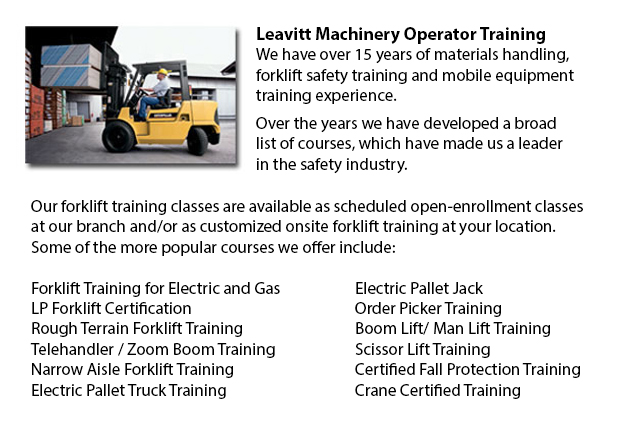
Ontario Forklift Training Schools - What Our Forklift Training Prgrams Can Provide Your Company
Are you searching for a job as a driver of a forklift? Our regulatory-compliant mobile equipment operator training offers instruction in kinds of lift trucks, pre-shift check, fuel types and handling of fuels, and safe operation of a forklift. Hands-on, practical training assists individuals participating in obtaining essential operational skills. Course content covers current rules governing the use of lift trucks. Our proven forklift Schools are designed to provide training on these types of trucks: narrow isle forklift, counterbalanced forklift and powered pallet truck.
While the lift truck is in use, do not lower or raise the forks. Loads must not extend over the backrest. This is due to the possibility of the load sliding back in the direction of the operator. Check for overhead obstructions and ensure there is enough clearance prior to raising a load. Stay away from overhead power lines. When the load is raised straight up, tilt it slightly back.
While the load is raised the lift truck will be less steady. Make sure that no pedestrians cross underneath the elevated fork. The operator must never leave the lift truck while the load is raised.
While handling pallets, forks should be level and high enough to go into the pallet and extend all the way below the load. The width of the forks must provide even weight distribution.
Set the brakes and chock the wheels before unloading and loading the truck. The floors should be strong enough to support the weight of both the load and the forklift. Fixed jacks can be installed to be able to support a semi-trailer which is not attached to a tractor. The entrance door height should clear the forklift height by a minimum of 5 cm. Mark edges of rail cars, ramps or docks and avoid them.
-
Ontario Manlift Certification
Ontario Manlift Certification - The Elevated Platforms and Manlifts Certification course helps to provide the required training on the work practices, safe operating procedures, regulations and rules regarding the everyday activities for the operator... More -
Ontario Crane Training
Ontario Crane Training - Bridge cranes or overhead cranes are actually a type of industrial material handling crane making use of a line and hook mechanism that runs on a horizontal beam running along two widely separated rails. Various overhead cran... More -
Ontario Aerial Lift Train the Trainer
Ontario Aerial Lift Train the Trainer - The Aerial Lifts Train the Trainer Certification Program teaches trainers how to effectively train operators in safe industrial mobile machinery operation. Trainers are given in-depth instruction about aerial l... More -
Ontario Warehouse Forklift Training Classes
Ontario Warehouse Forklift Training Classes - The reason for warehouse training classes are to raise the awareness of common workplace dangers. The trainees will learn essential warehouse safety procedures. An emphasis is placed on paying attention t... More -
Ontario Forklift Training School
Ontario Forklift Training School - Forklift Training School - Industry and federal regulators have established the criteria for forklift safety training based on their current standards and regulations. Those wanting to operate a forklift must finish... More -
Skid Steer Loader Training in Ontario
The engine powered skid-steer loader consists of a rigid and small frame, equipped along with lift arms that could attach to lots of industrial tools and attachments to execute many labor saving jobs. Normally, skid-steer loaders are four-wheel drive... More -
Ontario Crane License
Ontario Crane License - Crane operators ought to be "credentialed", that means they ought to own a crane operator certification or license. Credentialing is considered a mandatory governmental requirement to be able to practice as an operator of a cr... More -
Ontario Forklift Operator Training
Ontario Forklift Operator Training - Forklift training is a prerequisite in North America and is intended to prevent workplace injuries and death. Forklift training offers driver training intended for forklift operators. Training programs teach the s... More

Forklift Certification Ontario
TOLL FREE: 1-888-254-6157
Toronto, Ontario
forkliftcertificationontario.com
Email Us
About Us


